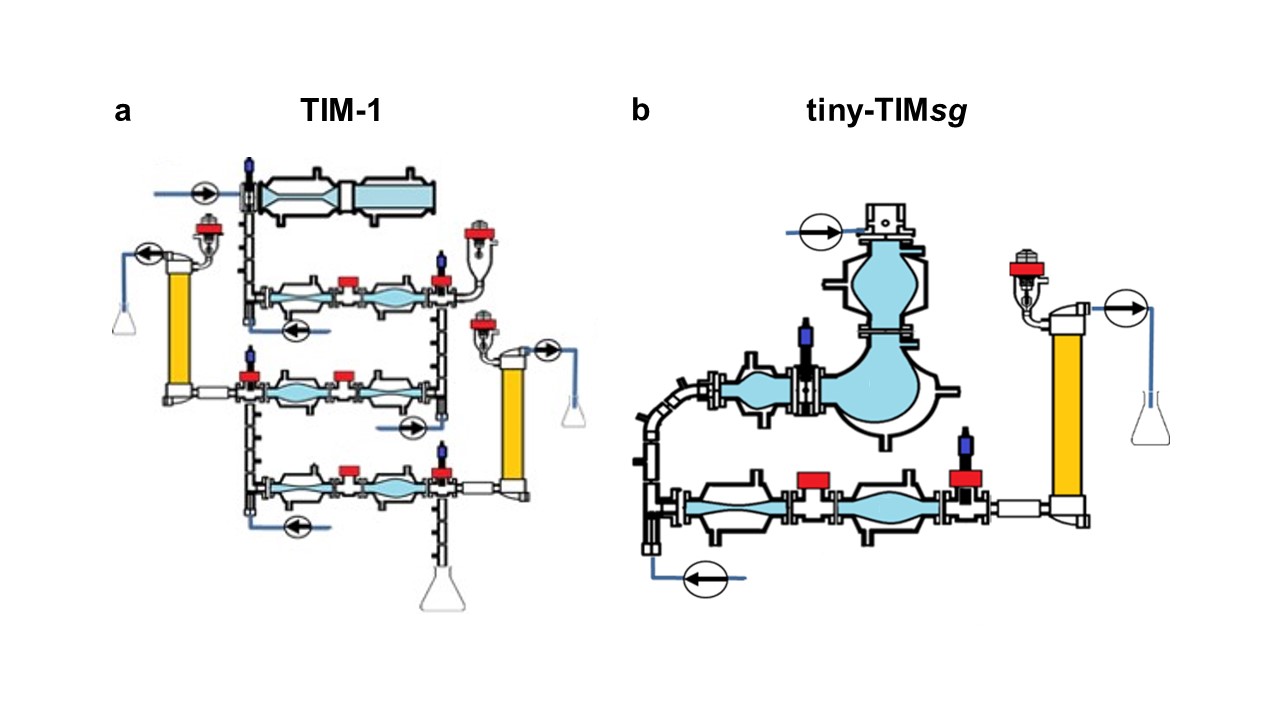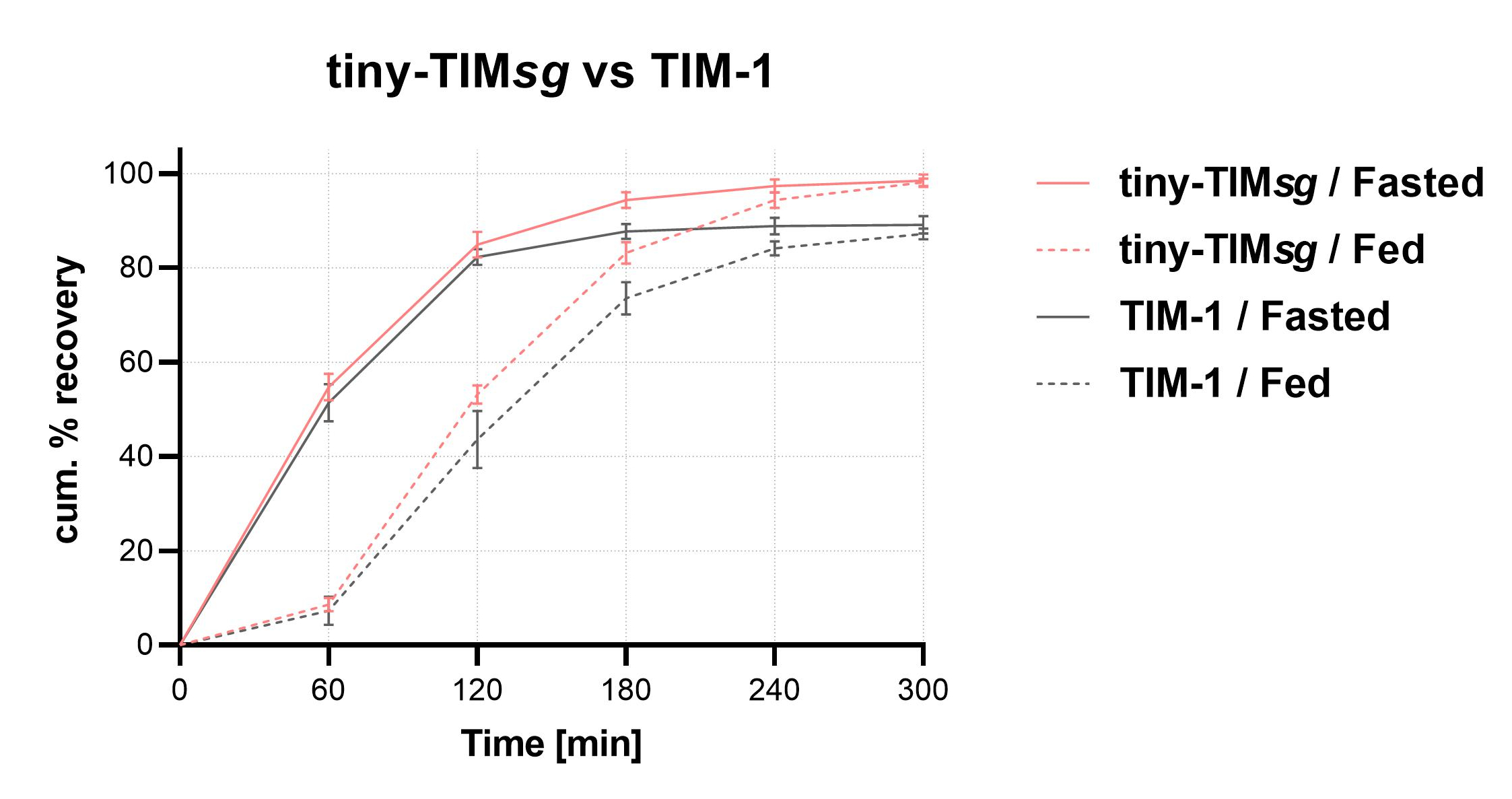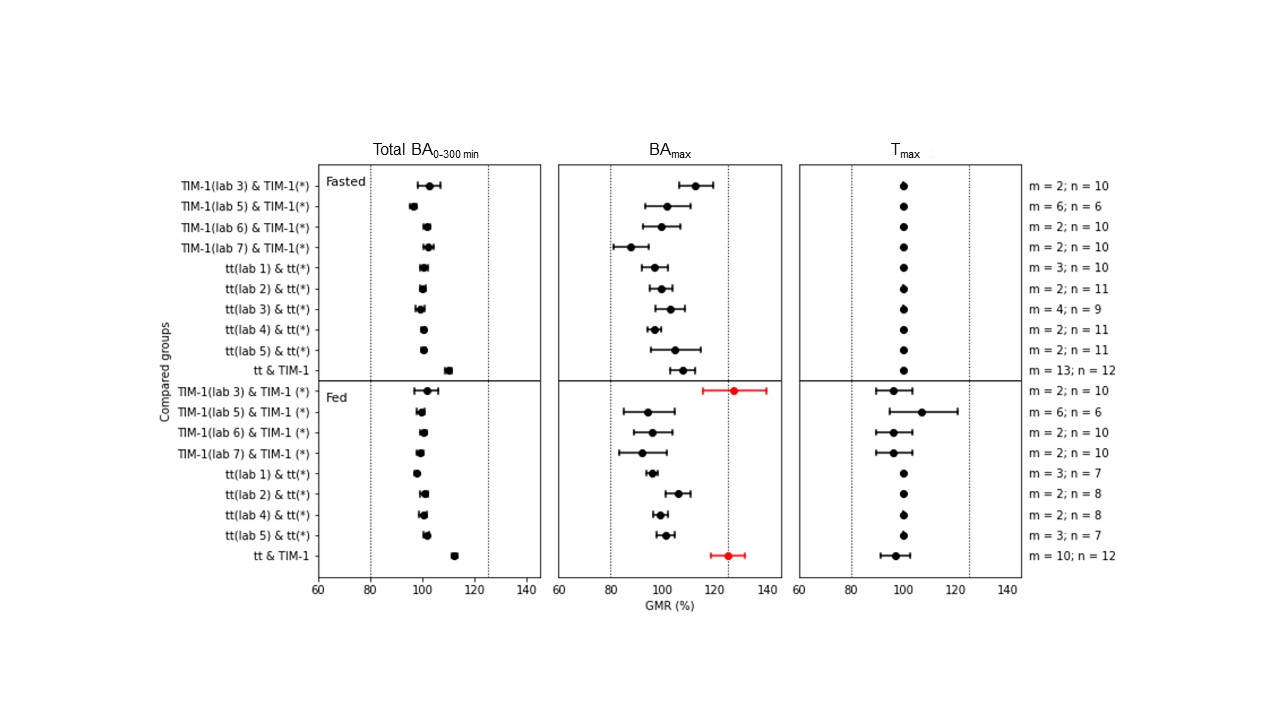Preclinical and Translational Sciences - Biomolecular
Category: Late Breaking Poster Abstract
(M1530-10-64) Repeatability and Reproducibility of Simulated Fasted and Fed State Gastrointestinal Conditions and Paracetamol Bioaccessibility in the Dynamic In Vitro Models TIM-1 and Tiny-TIMsg
.jpg)
Tânia Martins Garcia, PhD (she/her/hers)
Project Manager
TIM Company, The
Delft, Zuid-Holland, Netherlands.jpg)
Tânia Martins Garcia, PhD (she/her/hers)
Project Manager
TIM Company, The
Delft, Zuid-Holland, Netherlands- DM
Dyko Minekus, M.S.
TIM Company, The
Delft, Zuid-Holland, Netherlands - RB
Richard Barker, B.S.
AstraZeneca
Macclesfield, England, United Kingdom - JB
James Butler, Ph.D.
GlaxoSmithKline plc
London, England, United Kingdom - IS
Inese Sarcevica, Ph.D.
Pfizer Inc.
Kent, England, United Kingdom - KS
Kieran Smith, M.S.
Pfizer Inc.
Kent, England, United Kingdom - MS
Malgorzata Strozyk, B.S.
GlaxoSmithKline plc
London, England, United Kingdom - IT
Irena Tomaszewska, Ph.D.
Pfizer Inc.
Kent, England, United Kingdom - TO
Tom Ooms, M.S.
Janssen
Beerse, Antwerpen, Belgium - RS
Robert Schwabe, M.S.
Boehringer Ingelheim
Ridgefield, Connecticut, United States - AW
Andrea Wahl, M.S.
AbbVie Inc.
Ludwigshafen, Rheinland-Pfalz, Germany - AL
Alvaro Lopez Marmol, Ph.D.
AbbVie Inc.
Ludwigshafen, Rheinland-Pfalz, Germany - SB
Susann Bellmann, M.S.
TIM Company, The
Delft, Zuid-Holland, Netherlands
Presenting Author(s)
Main Author(s)
Co-Author(s)
Purpose: Gastrointestinal in vitro models that simulate the dynamic luminal conditions of the stomach and small intestine are valuable tools for the investigation of oral drugs. The TIM-1 and tiny-TIMsg systems have been shown to accurately predict oral bioavailability (Luo et al. 2022, López Mármol et al. 2022, Chiang et al. 2022, Liu et al. 2021, Verwei et al. 2016, Barker et al. 2014, Souliman et al. 2007, Souliman et al. 2006). These multi-compartmental models replicate the continuous and controlled physiological secretion of gastrointestinal fluids and passive absorption of digested food and solubilized drug compounds. Besides, the chyme formed in the stomach compartment gradually transits to the small intestine compartment(s) and is mixed by peristalsis movements. It is crucial to ensure that such complex luminal gastrointestinal kinetics can be tightly reproduced, not only between experiments but also between different pharmaceutical laboratories. This study aimed to evaluate the repeatability and reproducibility of the bioaccessibility of paracetamol measured under simulated fasted and fed conditions in the TIM-1 and tiny-TIMsg systems.
Methods: The TIM-1 and tiny-TIMsg experiments were performed in four and five different laboratories, respectively (Figure 1). Paracetamol powder (500 mg) was added to the gastric compartment together with water (fasted state) or high-fat meal (fed state). The average conditions of a healthy human individual were simulated for a total duration of 300 minutes. Gastric juice comprised of hydrochloric acid, pepsin, lipase, amylase, and electrolytes was secreted into the stomach compartment. Bicarbonate, fresh porcine bile, pancreatic juice containing digestive enzymes, and electrolytes were secreted into the small intestine compartment(s). Polysulfone plasma filters (50 nm cut-off and 0.3 m2 surface area were connected to the jejunal and ileal (TIM-1) or small intestine (tiny-TIMsg) compartments to remove the solubilized compounds (nutrients and paracetamol) that would be available for absorption in vivo (bioaccessible). Paracetamol concentration in filtrate samples was analyzed by UPLC-UV. Results were corrected for the paracetamol amount recovered at the end of each experiment, i.e. the mass balance. The geometric mean ratio (GMR) and lower and upper bound 90 % confidence intervals (90 % CI) were calculated between each laboratory and the pool of the remaining laboratories, for the total bioaccessibility (Total BA0-300 min), maximum bioaccessibility (BAmax), and associated time (Tmax). Results were deemed equivalent if GMR was within the 80% - 125% confidence interval.
Results: A small variability in paracetamol bioaccessibility was observed between the different laboratories for both TIM systems and conditions tested (Figure 2; standard deviation with TIM-1/TIM-1agc was 0.0-4.3 % and 0.0-6.5 % and with tiny-TIMsg was 0.0 – 2.2 % and 0.0-2.0 % of recovery, for fasted and fed state, respectively). The cumulative paracetamol bioaccessibility-time profiles were similar between fasted and fed states, despite the approximate one-hour delayed onset in the presence of food. This is in agreement with previous findings (Souliman et al., 2006). The tiny-TIMsg resulted in slightly higher total paracetamol bioaccessibility compared to TIM-1 (89.8 vs 98.5 % in fasted state and 87.4 vs 98.2 % of recovery in fed state, for TIM-1/TIM-1agc and tiny-TIMsg, respectively). This could be explained by the emptying of effluent from the ileal compartment in the TIM-1 through the simulated ileocecal valve, which is not present in the tiny-TIMsg system. Statistical analysis confirmed that Total BA0-300 min, BAmax, and Tmax were equivalent between all laboratories for both fasted and fed state, as well as between the TIM-1 and tiny-TIMsg systems (Figure 3). Only the BAmax, in fed state was not equivalent between the laboratories with TIM-1/TIM-1agc systems and between TIM-1 and tiny-TIMsg. This is probably driven by laboratory 3 that performed the experiments in the TIM-1agc. The TIM-1agc is equipped with the J-shaped advanced gastric compartment (TIMagc) instead of the horizontal conventional stomach, allowing quicker emptying of liquids (containing dissolved paracetamol) compared to solids (Bellman et al. 2016).
Conclusion: The high repeatability and reproducibility of the TIM-1 and tiny-TIMsg systems contribute to the reliability of the TIM results. Paracetamol can be used as an internal marker for parameter performance of the TIM systems at different locations.
References: Barker, R., Abrahamsson, B., Kruusmägi, M. (2014). Application and validation of an advanced gastro-intestinal in vitro model for evaluation of drug product performance in pharmaceutical development. J. Pharm. Sci. 103 (11): 3704-3712.
Bellmann, S., Lelieveld, J., Gorissen, T., Minekus, M., Havenaar, R. (2016). Development of an advanced in vitro model and its evaluation versus human gastric physiology. Food Res. Internat. 88: 191-198.
Chiang, P. C., Liu, J., Nagapudi, K., Wu, R., Dolton, M. J., Salehi, N., & Amidon, G. (2022). Evaluating the IVIVC by Combining Tiny-tim Outputs and Compartmental PK Model to Predict Oral Exposure for Different Formulations of Ibuprofen. Journal of Pharmaceutical Sciences.
Liu J, Nagapudi K, Dolton MJ, Chiang PC. Utilizing Tiny-TIM to Assess the Effect of Acid-Reducing Agents on the Absorption of Orally Administered Drugs. J Pharm Sci. 2021 Aug;110(8):3020-3026. doi: 10.1016/j.xphs.2021.04.017. Epub 2021 Apr 30. PMID: 33940027.
Luo, L., Thakral, N. K., Schwabe, R., Li, L., & Chen, S. (2022). Using Tiny-TIM Dissolution and In Silico Simulation to Accelerate Oral Product Development of a BCS Class II Compound. AAPS PharmSciTech, 23(6), 1-10.
Mármol, Á. L., Fischer, P. L., Wahl, A., Schwöbel, D., Lenz, V., Sauer, K., & Koziolek, M. (2022). Application of tiny-TIM as a mechanistic tool to investigate the in vitro performance of different itraconazole formulations under physiologically relevant conditions. European Journal of Pharmaceutical Sciences, 106165.
Souliman S, Blanquet S, Beyssac E, Cardot JM. A level A in vitro/in vivo correlation in fasted and fed states using different methods: applied to solid immediate release oral dosage form. Eur J Pharm Sci. 2006 Jan;27(1):72-9. doi: 10.1016/j.ejps.2005.08.006. Epub 2005 Sep 19. PMID: 16169713.
Souliman S, Beyssac E, Cardot JM, Denis S, Alric M. Investigation of the biopharmaceutical behavior of theophylline hydrophilic matrix tablets using USP methods and an artificial digestive system. Drug Dev Ind Pharm. 2007 Apr;33(4):475-83. doi: 10.1080/03639040601128654. PMID: 17523011.
Verwei, M., Minekus, M., Zeijdner, E., Schilderink, R., Havenaar, R. (2016). Evaluation of two dynamic in vitro models simulating fasted and fed state conditions in the upper gastrointestinal tract (TIM-1 and tiny-TIM) for investigating the bioaccessibility of pharmaceutical compounds from oral dosage forms. Int. J. Pharm. 498: 178-186.
Acknowledgements: TMG, DM, and SB are employees of The TIM Company. RB is employee of AstraZeneca. JB and MS are employees of GlaxoSmithKline R&D. IS, KS, and IT are employees of Pfizer. TO is employee of Janssen. RS is employee of Boehringen Ingelheim. AW and ALM are employees of AbbVie Deutschland GmbH & Co. KG
 Fig. 1 – Schematic representation of the (A) TIM-1 system with conventional horizontal gastric compartment and three small intestinal compartments simulating the duodenum, jejunum, and ileum, and of the (B) tiny-TIMsg system with the advanced gastric compartment (TIMagc) and one small intestinal compartment. The filters that collect the bioaccessible paracetamol are indicated in yellow.
Fig. 1 – Schematic representation of the (A) TIM-1 system with conventional horizontal gastric compartment and three small intestinal compartments simulating the duodenum, jejunum, and ileum, and of the (B) tiny-TIMsg system with the advanced gastric compartment (TIMagc) and one small intestinal compartment. The filters that collect the bioaccessible paracetamol are indicated in yellow. Fig. 2 – Cumulative total bioaccessibility of paracetamol (% recovey) per 60 min time intervals in the TIM-1 system (blue lines) and in the tiny-TIMsg (red lines) under fasted state (solid lines) and fed state conditions (dotted lines). Mean ± S.D (TIM-1: n=12 in 4 laboratories; tiny-TIMsg: n=13 in 5 laboratories and n=9 in 4 laboratories, for fasted state and fed state, respectively.)
Fig. 2 – Cumulative total bioaccessibility of paracetamol (% recovey) per 60 min time intervals in the TIM-1 system (blue lines) and in the tiny-TIMsg (red lines) under fasted state (solid lines) and fed state conditions (dotted lines). Mean ± S.D (TIM-1: n=12 in 4 laboratories; tiny-TIMsg: n=13 in 5 laboratories and n=9 in 4 laboratories, for fasted state and fed state, respectively.) Fig. 3 – Equivalence comparison for Total BA0-300 min, BAmax, and Tmax in fasted state and fed state conditions. Each line indicates the comparison between one laboratory and the pool of the remaining laboratories with the same TIM system (*). The last line indicates the comparison between TIM-1 and tiny-TIMsg (tt). m indicates the number of replicates per laboratory; n indicates the number of replicates per laboratory pool; vertical lines enclose 80% and 125% confidence interval to conclude equivalence of compared groups; dots indicate the GMR and bars the confidence interval.
Fig. 3 – Equivalence comparison for Total BA0-300 min, BAmax, and Tmax in fasted state and fed state conditions. Each line indicates the comparison between one laboratory and the pool of the remaining laboratories with the same TIM system (*). The last line indicates the comparison between TIM-1 and tiny-TIMsg (tt). m indicates the number of replicates per laboratory; n indicates the number of replicates per laboratory pool; vertical lines enclose 80% and 125% confidence interval to conclude equivalence of compared groups; dots indicate the GMR and bars the confidence interval.